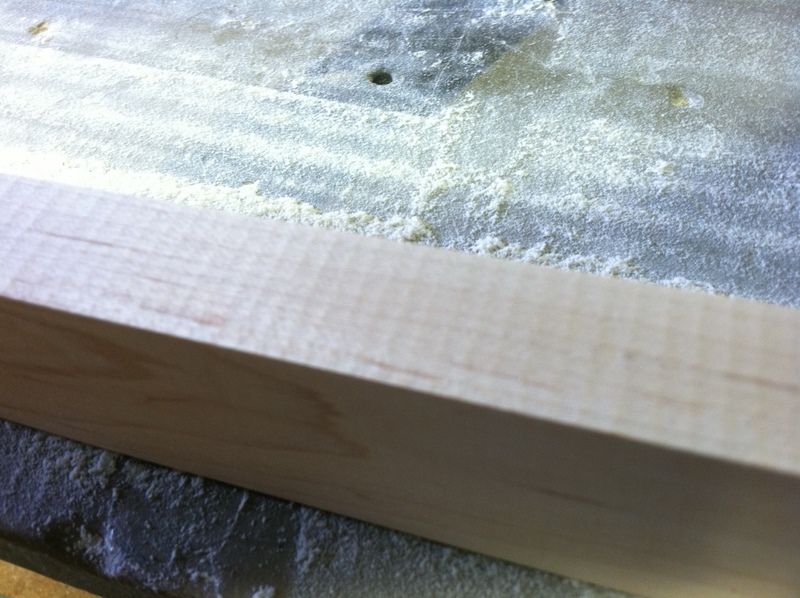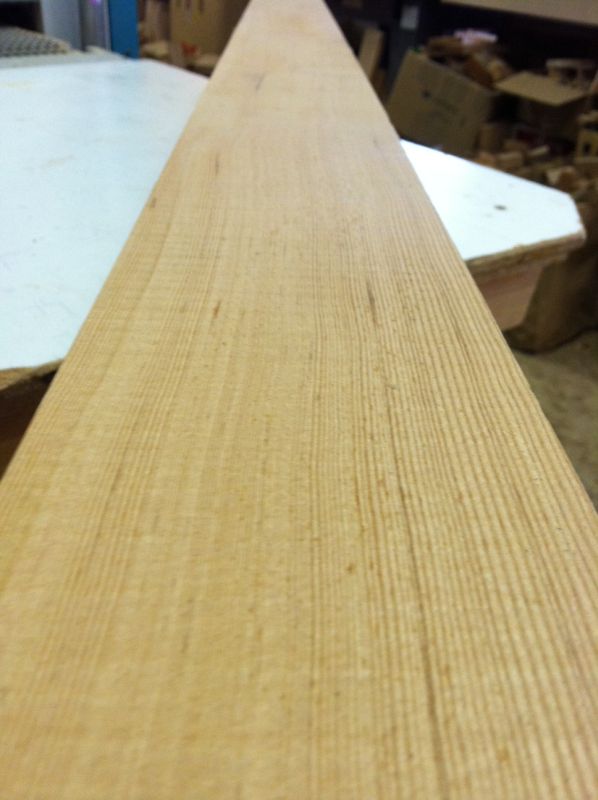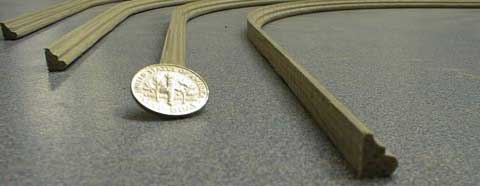Jointer Chatter Marks
With help from the forum, a problem with a jointer is traced to the bearings. October 29, 2012
Question
Can anyone give me some tips on how to remove the chatter marks being left by my Delta 8" jointer? I have had the jointer since 2003. I just replaced the knives and started to joint some hard maple and kept getting these chatter marks. Could the head bearings be going? I'm stumped. I checked the infeed and outfeed tables for straightness.

Click here for higher quality, full size image
Forum Responses
(Solid Wood Machining Forum)
From contributor M:
One of your blades is out of alignment with others. Only one blade is cutting.
From the original questioner:
I set all the knives with a dial indicator. All three knives should be within .003 of each other.
From contributor J:
A bearing going bad can cause this. Check the head for play or bearing noise if you are confident the knives are correct. We had this happen on a Tersa head.
From the original questioner:
I'm going to investigate the head bearings. I have been hearing some whining noise but it comes and goes.
From Professor Gene Wengert, Sawing and Drying Forum technical advisor:
We see these marks when feeding fast (the normal hills and valleys of a planer) or when one knife extends further than the others, giving a hill and valley. Unless the head is badly unbalanced, a bearing would not give such a uniform pattern.
From contributor N:
Check your knives with a straight edge off from the outfeed table. You get this when you have one knife higher than the others.
From contributor J:
As I said, if you are confident the knives are good, start looking at bearings. Here is a poor picture of material planed when the bearing was going. It is a uniform scallop that continued to get worse but was still uniform.
This was a Tersa bottom head in our S4S machine. It started as a small vibration and later developed into a noise that came and went like you are describing. Several “experts” said it could only be a high knife. I spent a lot of time cleaning the head, changing belts and checking the head and knives with a dial indicator. Rotating by hand, the head or knives never showed being out. If I were a better mechanic the bearing noise probably could have been detected with a long screwdriver to the ear. It finally went out quickly and damaged the head. Would have been a lot cheaper to change the bearings early on.

Click here for higher quality, full size image
From contributor R:
That does not look like chatter to me. Looks like a one knife finish. If you don't like it, slow down your feed rate. It is impossible to get a multiple knife finish without jointing.
From Professor Gene Wengert, Sawing and Drying Forum technical advisor:
Contributor J, I wonder if you checked to see if the head was balanced. Even though there is a lot of metal in a head, sometimes unbalance will cause the head to bend slightly and create, when spinning, the marks we see. When that happens, one knife is doing more work than the others. Of course, the unbalance also causes stress and wear on the bearings.
Regarding the idea that one knife is projecting more than the other, this can be determined easily by measuring the distance between each ridge (in the original picture, for example). Then calculate what the distance would be if each knife is working equally. This distance is
D = (12 * F) / (T * N)
where D = distance between ridges in inches
F = feed speed in feet per minute (you can measure this)
T = number of knives per head
N = head speed in rpm
R = the radius (1/2 the diameter) of the head including the projection distance of the knives
(The 12 is to convert the feed speed into inches per minute.)
If the questioner can do this calculation, we will have a better idea of what is happening.
From Dave Rankin, forum technical advisor:
Is the jointer head direct drive or belt driven? If it is belt driven, then you may have a bad belt. Incorrect balance of the knives is a very good possibility. I have several moulder operators that run 1 knife and a balancer and get a single knife finish. This will produce a very good finish. Not as good as running 2 balanced knives. Before I replace bearings I check the above so that a new set of bearings will not be damaged. Something to think about with balance. At 6000 rpm, 1 gram out of balance is equal to about 22 pounds of force.
From contributor J:
Hi Gene, it was not a balance problem. The machine is a Martin T90 S4S moulder - planer. The heads are a different animal than most. They are fixed Tersa heads with 2 large outboard bearings. The shaft and head are one piece. It is a very solid, vibration-free machine.
We have had the machine for 10 years. The problem started a couple years ago. Up to this point the machine gave a perfect finish. After changing the bearings, we are getting a perfect finish again.
As to what caused the bearings to fail, I have a couple ideas. About a year before things started to go south, we ran a large recycled oak flooring job and let the knives get a little too dull. I think this could have caused stress on the bearings. We grease the bearings according to the manufacturer's recommendation. Martin says over-greasing can cause failure, but I don't think we ever did this.
We also looked at and changed the belts. We have had belts go bad, but that never seemed to effect the finish. Just made a lot of racket. All is good now.
From the original questioner:
I removed the head today and the left bearing was bad. Ordered new German made bearings that will be here tomorrow to install.
From the original questioner:
I installed the new bearings and put everything back together. I'm pleased to let everyone know that I'm back to jointing a clean smooth edge. Thanks for your help.


